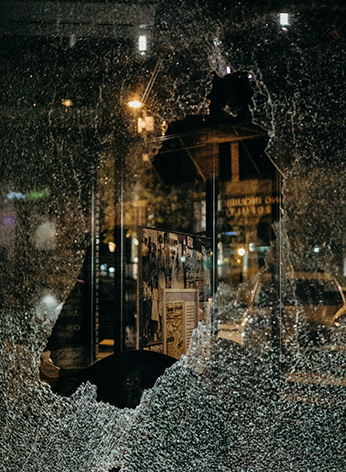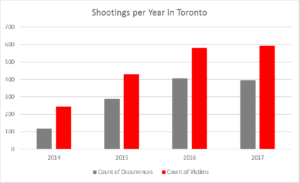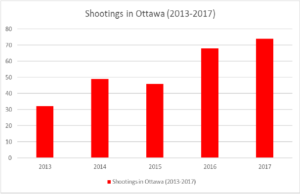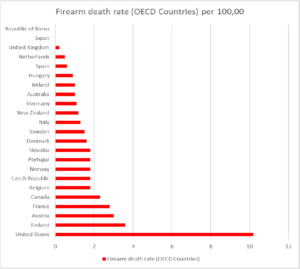Evacuations from Israel and High-Risk Locations Call +44 (0)1202 308810 or Contact Us →

Gun Violence Rises in Canada
21 Aug 2018
Canada has traditionally had low levels of crime and gun violence. 2018, however, has been a year of record violence within the city of Toronto. In the past year, there has been a significant increase in shootings and firearm-related deaths. 2017 saw 594 victims of shootings, the greatest in at least four years. The recent spike in gun violence has led Canada’s ruling party to unveil gun control measures to be implemented in 2019. The latest measures are set to include tougher background checks and screening, along with enhanced record keeping of gun sales and inventories. Gun control measures were included in the manifesto of the ruling Liberal Party during the 2015 election, though it has taken recent events to press them to take action.
Key Points
- Gun violence-related deaths have risen by 53 per cent in 2018, while shootings in general have increased by 13 per cent.
- Tighter gun control measures are to be implemented across Canada by 2019.
- 200 additional police officers were deployed in Toronto in July 2018.
Situational Summary
Crime: Canada has traditionally had low levels of crime and gun violence. 2018, however, has been a year of record violence within the city of Toronto. In the past year, there has been a significant increase in shootings and firearm-related deaths. 2017 saw 594 victims of shootings, the greatest in at least four years. The recent spike in gun violence has led Canada’s ruling party to unveil gun control measures to be implemented in 2019. The latest measures are set to include tougher background checks and screening, along with enhanced record keeping of gun sales and inventories. Gun control measures were included in the manifesto of the ruling Liberal Party during the 2015 election, though it has taken recent events to press them to take action.
Gun violence has been widely reported in local media due to the recent attacks in Toronto and Fredericton, New Brunswick. On 23 July 2018, a lone gunman opened fire in the Greektown district of Toronto, an area popular for its restaurants. The attack resulted in the deaths of a 10-year-old girl and an 18-year-old woman. The attack has been claimed by terrorist group Islamic State, however, no evidence has yet linked the suspect with the group. This group often claim responsibility for attacks of which they may not have directly conducted. The latest high-profile shooting saw two police officers and two civilians shot dead in Fredericton on 10 August 2018. The motive behind the most recent attack remains unconfirmed and the attacker remains in police custody.
Solace Global Comment
Gun Crime Statistics
In Toronto, shootings are reported to have increased by 13 per cent since 2017, with the number of deaths, as a result, increasing by 53 per cent. Toronto’s police department claims this increase is related to ongoing gang violence and have addressed the evident gun problem with talks of greater implementation of gun control measures. In addition to a rise in shootings, Toronto’s police force has been investigating a series of high profile homicides within the past 18 months. This includes the double murder of two billionaires in May 2018.
Gun violence has also increased within rural areas. In Canada, three out of 10 violent gun crimes are reported outside of a major city. Overall, the Territories (Dehcho, Slave, Sahtu, and Inuvik) and Saskatchewan have the highest rates of firearm-related violent crime. The Canadian capital Ottawa has also seen a rise in shootings over the past five years. Ontario as a whole, however, reported 10 fewer homicides in 2017 than in 2016.


Reasons for Increased Gun Crimes.
Canada’s government currently invests over 400 million Canadian dollars a year to help combat criminal gun and gang violence. Increased investment into preventing gang violence came on the back of figures suggesting that there were 141 gang-related homicides in 2016 an increase of 45 from the 96 reported in 2015. Investments are aimed at providing support for strategies such as the Youth Gang Prevention Programme and other community-based crime prevention programmes. The focus on targeting vulnerable and underdeveloped communities is where Canada believes it will most impact reducing the number of young people turning to gangs. The programmes are intended to provide the young and marginalised with alternative opportunities for work and social activities. This form of intervention is widely supported by criminology research, which suggests that gangs often fill an essential social role when no other options exist. However, this type of intervention is unlikely to counteract the rise in firearms incidents where gang activity is not the motive.
Despite Canadian police officials claiming there is a persistent gang problem, there also remains the threat of lone wolf gun attacks, such as that of the 23 July 2018 in Toronto where the suspect had a history of mental illness. Prior to this, there were two mass shooting attacks in January 2017 and January 2016. On both occasions, the shootings were carried out by a single gunman. The January 2017 shooting, which saw the deaths of six worshippers at a Quebec City Mosque, was described as an act of terror. The incident in January 2016 involved another suspect suffering from mental illness and a link to cognitive impairments. The evidence from these attacks clearly indicates gun violence is not limited to gang activities. It is important to note that although high-profile mass shootings have occurred recently in Canada, they still remain rare.
Potential Outcomes Following Increased Gun Violence.
Although there have been ongoing plans to address the issue of gun violence, the most recent high-profile shootings in Toronto and Fredericton shows that measures to tackle the growing issue are required with some urgency. It is possible that rallies or demonstrations surrounding gun control measures will develop in the wake of both shootings. Unrest in the United States following mass shootings indicates the probability of demonstrations of a similar nature across Canada. Much like the protests in the US against the National Rifle Association (NRA), the Canadian Coalition for Firearm Rights (CCFR) advocacy group is likely to be targeted by such movements. The CCFR’s leader, Rod Giltaca, has raised concerns over the proposed legislation and new gun laws, likely indicating his group’s continued resistance to such measures.
Current Gun Control Laws
Canada requires that all gun owners be licensed, and weapons registered. All weapons are expected to be stored unloaded and locked away. Unless specifically granted, Canadian law does not allow weapons to be carried in public. Prospective gun owners must also receive safety training and undergo a background check. In recent times, there has been an identified increase in the buying and selling of illegal firearms. The opportunities to buy and sell weapons through illegitimate means gives rise to the current issues surrounding gun crime and is subsequently associated with gang violence.
What Has Been Done?
On 20 July 2018, a further 200 police officers were deployed in Toronto in response to the recent increase in shootings. New laws will allow more extensive checks to be made and a greater record to be kept of firearm inventories and sales. Whilst gun licensing systems are tightening, the growing problem with illegal weapons is likely to grow. Although there is a proactive approach worldwide to creating greater gun control laws there remains a lack of focus on the motives behind attacks. Mental instability has been a common feature among many attackers. Both in Germany and Switzerland there has been a greater emphasis on the psychological cues surrounding potential perpetrators in the countries’ crime prevention campaigns. As seen in Switzerland, a component of applying for gun ownership involves a psychological screening, a key factor that is believed to contribute to low levels of gun crime despite high levels of gun ownership.
Conclusion
Despite the recent increase in gun violence, mass shootings are rare in Canada. In comparison to the United States, a firearm remains seven times less likely to be used in a homicide in Canada than in the US. Despite this, there is a heightened threat level of gun violence when compared to Europe as a whole or the OECD (Organisation for Economic Co-operation and Development) average. The government attempts to address the increase in gun crime is providing a positive outlook for the future risk of being a victim of gun crime, however, the implementation of such measures is likely to take time. The discussions over gun control measures are advised to be seen as a way of reducing the occurrence of such crimes and not as a complete prevention measure.

SECURITY ADVICE
CrimeLowAlthough gun violence is on the rise, the likelihood of attacks occurring and targeting foreign travellers is low. The biggest threat to travellers remains that of petty theft and opportunistic crimes. Travellers should ensure they keep valuables safe and avoid displaying overt signs of wealth.
If caught in a terror situation, travellers are advised to RUN – HIDE – TELL – FIGHT.
RUN – If in a location where gunfire or explosions are heard, leave the area or building by any safe and available exit immediately.
HIDE – If unable to run away, find suitable cover or barricade yourself in a room. Remember to silence your phone and turn vibrate off.
TELL – Inform emergency services or alert someone who is able to do it for you. Once police arrive, comply with their instructions and do not make any sudden movements.
FIGHT – As a last resort, if confronted with a gunman, it is recommended to fight back by using the element of surprise by shouting, screaming and running fast at the attacker. If sheltered with others, convince them to do the same and rush the attacker all at once. Ensure the person entering the shelter is the attacker and not law enforcement.
Travellers to Canada are advised that enhanced security measures are not generally necessary. However, travellers should employ travel tracking technology alongside an intelligence platform. This will enable them to quickly notify others of an emergency and be kept updated of any security-related incidents.